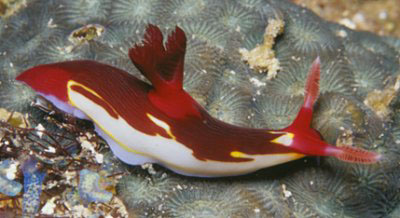
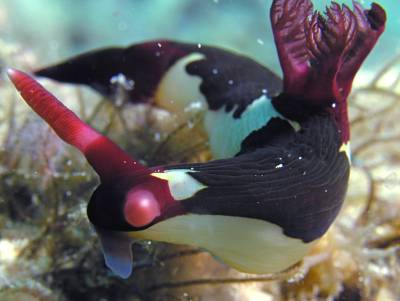
Nembrotha chamberlaini
Gosliner & Behrens, 1997
Order: NUDIBRANCHIA
Suborder: DORIDINA
Family: Polyceridae
Subfamily: Nembrothinae
DISTRIBUTION
Known only from the Philippines & Indonesia.
PHOTO
Upper: Batangas, Philippines, May, 2001. Photo: Mary Jane Adams. Lower: Lilo-an, Santander, Cebu Is, Philippines. Depth: 10m., 20 Sept 2003. Size: approx 35mm. Photo: Yukari Sato
This recently described species has a very distinctive colour pattern. In Gosliner & Behren's description one photo shows the patch around the base of the gills and rhinophores to be bright red - the same colour as the rhinophores and gills -, while in a second photo the basal patch around the gills, and the gills, are reddish brown. In Erwin Koehler's photo, both gills and basal region are dark brownish black. Gosliner, Behrens & Williams (1996) report it feeding on the ascidians Clavelina sp., Rhopalaea sp., & Oxycorynia sp..
References:
• Gosliner, T.M., Behrens, D.W. & Williams, G.C. (1997) Coral Reef Animals of the Indo-Pacific. 314pp. Monterey, California: Sea Challengers.
• Gosliner, T.M. & Behrens, D.W. (1997). description of four new species of phanerobranch dorids (Mollusca: Nudibranchia) from the Indo-Pacific, with a redescription of Gymnodoris aurita (Gould, 1852).
See also the similarly coloured Nembrotha sp. 8 and Nembrotha sp. 9
Authorship detailsRudman, W.B., 1998 (December 16) Nembrotha chamberlaini Gosliner & Behrens, 1997. [In] Sea Slug Forum. Australian Museum, Sydney. Available from http://www.seaslugforum.net/find/nembcham
Related messages
Nembrotha chamberlaini feeding
December 7, 2009
From: Dr. Carsten Harfmann
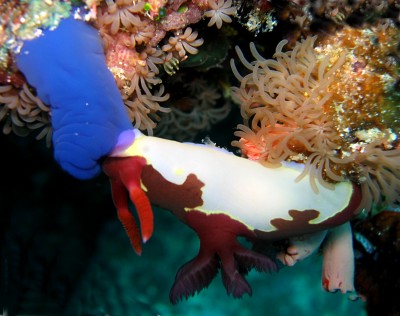
Dear Bill,
here is a further Nembrotha chamberlaini feeding on a blue solitary ascidian. Seems to be quite hungry.
Locality: Balicasac Island, Phillipines, 12 March 2007, Wall. Photographer: Dr. Christine Meier.
Best regards,
Carsten
harfmann.carsten@web.de
Harfmann, C., 2009 (Dec 7) Nembrotha chamberlaini feeding. [Message in] Sea Slug Forum. Australian Museum, Sydney. Available from http://www.seaslugforum.net/find/22887Thanks Carsten,
Always good to get another bit of feeding information
Best wishes,
Bill Rudman
Nembrotha chamberlaini from Malaysia?
December 7, 2009
From: Mirjam Broos
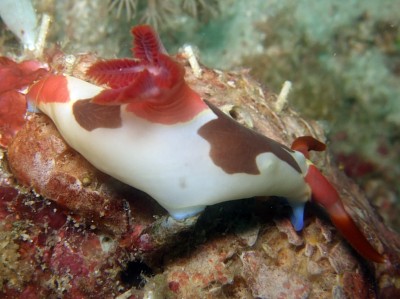
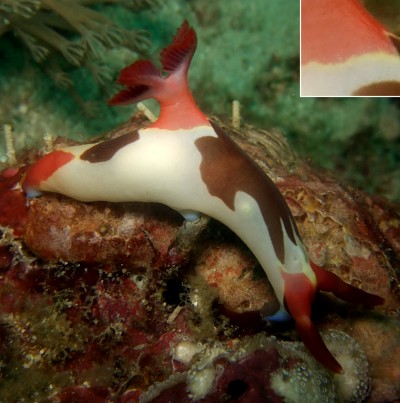
Hello Bill,
I really thought we found Nembrotha chamberlaini near Siamil Island, Malaysia (the colour of the gills extends on to the dorsum) but I read on the forum that N. chamberlaini only exists in Indonesia and the Philippines. So is this N. rutilans after all?
Locality: Siamil Island (near Kapalai), Froggy layer, Sabah, Malaysia, 27 september 2009. Photographer: Geert Prast.
best regard,
Mirjam
mirjam.broos@planet.nl
Broos, M., 2009 (Dec 7) Nembrotha chamberlaini from Malaysia?. [Message in] Sea Slug Forum. Australian Museum, Sydney. Available from http://www.seaslugforum.net/find/22877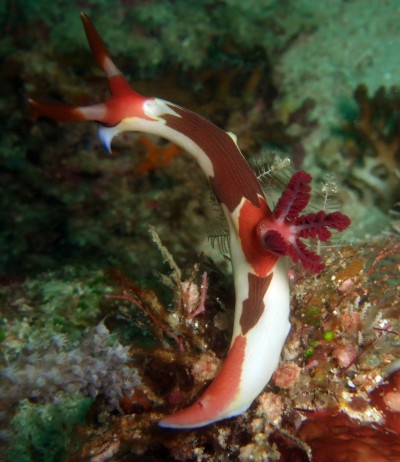
Dear Mirjam,
One of the exciting things about scientific discovery is that the written 'facts' are only as good as the last observation. At present this species has only been recorded from Indonesia and the Philippines but as you have found a specimen of N. chamberlaini in Malaysia then we will have to change the books. Most new scientific information expands like this by small steps, but as we have seen quite often on the Forum, our knowledge of geographic distribution of species can sometimes expand across an ocean in just one step.
One problem which is still unresolved though is just how many species there are in this colour group of Nembrotha species. Yours certainly fits the 'typical' colour form, but as to how much colour variation should be included in the species is still a puzzle. Photos such as yours can be very valuable in determining just how variable a colour pattern can be.
Best wishes,
Bill Rudman
Mating brown & green Nembrotha chamberlaini
September 15, 2009
From: Kara Miller
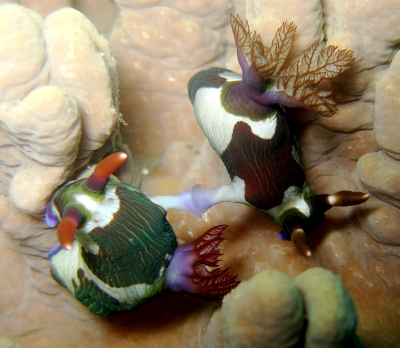
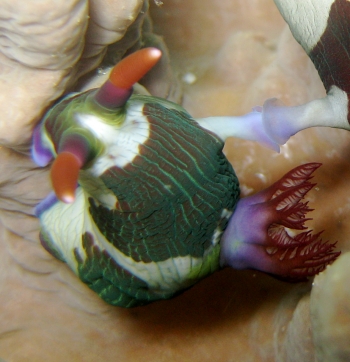
Found these guys on a live-aboard trip on the Pindito in Raja Ampat, the Banda Sea. They were very obviously mating on a coral head in about 20 feet of water. Dive spot was called Boo Island. This was the first of three pairs of mating nudibranchs I found on this trip; 2 pairs of nembrothas (different species) and one pair of terrilidias.
Locality: Raja Ampat (live-aboard), 20 feet, Indonesia, Banda Sea, 14 November 2008, Reef. Length: 3 inches. Photographer: Kara Miller.
Kara Miller
liveahimsa@gmail.com
Miller, K., 2009 (Sep 15) Mating brown & green Nembrotha chamberlaini. [Message in] Sea Slug Forum. Australian Museum, Sydney. Available from http://www.seaslugforum.net/find/22270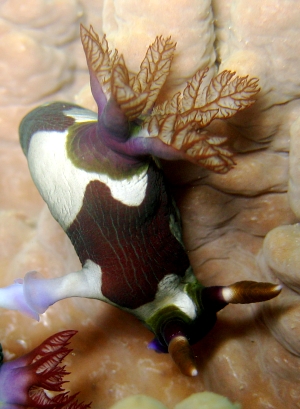
Dear Kara,
This sort of confirms my discussion in Marcel Tanke's message [#22310] that the brown and green [Nembrotha sp. 9] forms of N. chamberlaini are one species. But when you look at photos of the N. rutilans - N. purpureolineata group [see message #18775] it is hard to see how they differ - which ultimately brings us back to N. lineolata. See also my comments on this colour group in message #389.
Best wishes,
Bill Rudman
Re: Unicorn Nembrotha chamberlaini
September 15, 2009
From: Marcel Tanke
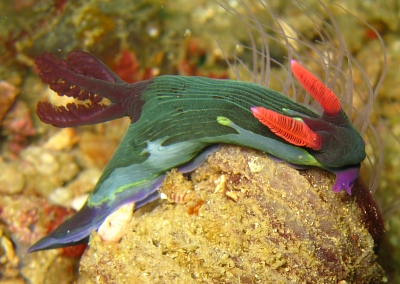
Dear Bill,
In an earlier message [#21649] you mentioned that this green coloured animal is a colour form of Nembrotha chamberlaini. I just want to bring to your attention that in the species list you refer to it as Nembrotha sp 9. Correct?
Locality: Puerto Galera, about 15 m, Philippines, 7 Februari 2008. Length: 10 cm. Photographer: Marcel Tanke.
In the Anilao and Puerto Galera areas of the Philippines these are quite common animals. In the N. chamberlaini Forum section, James McMahon's message [#21210] shows a similar colored animal. Attached is another one I have found.
Best regards,
Marcel
marceltanke@cs.com
Tanke, M.A., 2009 (Sep 15) Re: Unicorn Nembrotha chamberlaini. [Message in] Sea Slug Forum. Australian Museum, Sydney. Available from http://www.seaslugforum.net/find/22310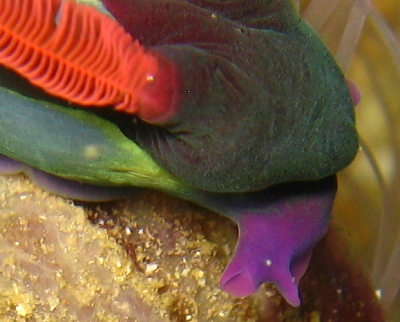
Dear Marcel,
You are quite correct. Initially I separated off the greenish ones as these seemed quite different but as more photos accumulate the differences between the green and brown forms look less significant. When I get a moment I should amalgamate Nembrotha sp. 9 with N. chamberlaini
Best wishes,
Bill Rudman
Nembrotha chamberlaini: The ART of laying eggs
September 15, 2009
From: Marcel Tanke
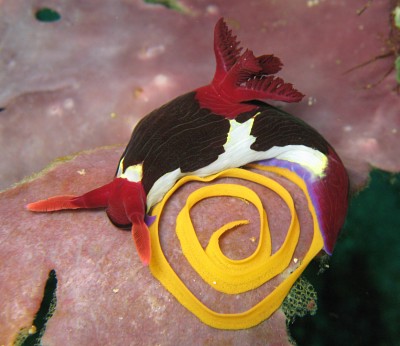
Dear Bill,
Following my message [#22310] of a green form of Nembrotha chamberlaini (which you also refer to as Nembrotha sp. 9), here is a photo of the brown form.
As I like this particular picture, I had it as my PC desktop for a while. So I had quite some time to study it. I here want to share this "study" with you:
The nudibranch has selected a relatively smooth, almost horizontal substrate to lay its eggs. It is producing a beautiful inside out, counter clockwise, yellow egg spiral. When zooming in to it, the individual small eggs in the gelatinous mass can clearly be seen. In the center of the egg spiral, the curvature is highest. As N. chamberlaini in the center of the spiral cannot feel a previously laid, reference egg spiral, it is difficult for the animal to keep a constant distance between the subsequent layers. It can be seen that after, say one and a half round, that becomes easier. Then, as seen in the picture, N. chamberlaini feels and checks the position of the previous round of egg spiral with its left, blue / purple oral tentacle. The upper half of its body is parallel and even touching the previous round of egg mass. And it is actually changing the angle of vertical position of the egg mass on the substrate, by pushing it inside.
The eggs are coming from the female opening on the right side of the body, which cannot be seen in this picture. The eggs are guided into position and pushed against the substrate between the two muscles that are located on both sides of the foot. Visible in the picture is the muscle on the left side of the foot, having the same blue / purple color as the oral tentacle. At the point of leaving the foot of the animal, the vertical position of the egg mass is still towards the outside of the spiral.
As the outer spiral already is somewhat outside the substrate, it would have been interesting to see how this N. chamberlaini would finish the spiral at that point.
An egg spiral will never look the same again...
Locality: Anilao, about 15 meter, Philippines, 29 December 2008. Length: about 10 cm. Photographer: Marcel Tanke.
Best regards,
Marcel
marceltanke@cs.com
Tanke, M.A., 2009 (Sep 15) Nembrotha chamberlaini: The ART of laying eggs. [Message in] Sea Slug Forum. Australian Museum, Sydney. Available from http://www.seaslugforum.net/find/22657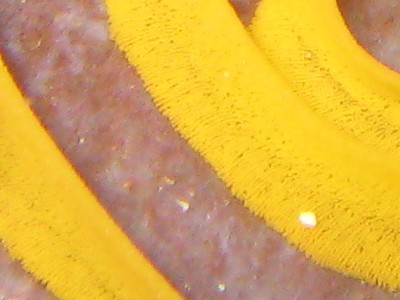
Dear Marcel,
Thanks for your observations. It is indeed amazing how such an apparently clumsy organ - such as a slug's foot can lay a spiral with such precision.
I think this is the first egg ribbon I have seen of this species. It is very similar to that of Nembrotha lineolata [see message #4740]. While two species can have very similar egg ribbons, I must say that I am not convinced that all the named species of Nembrotha are different. If you imagined the brown regions in your N. chamberlaini being replaced with brown lines, it would look very much like N. lineolata.
Best wishes,
Bill Rudman
Nembrotha chamberlaini feeding [2]
August 25, 2008
From: Marcel Tanke
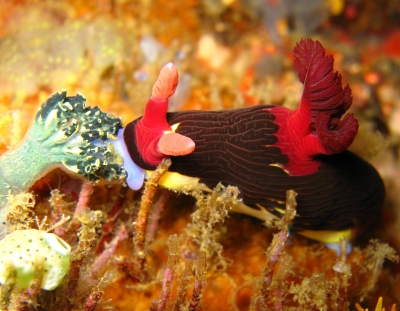
Concerning message #21651:
Hi Bill,
During our recent trip to Anilao we saw several more Nembrotha chamberlaini feeding on the same blue ascidian Rhopalaea; all through the 'mouth' opening of the Rhopalaea.
We saw even more N. chamberlaini feeding on the ascidian Clavelina. Some were devouring it 'head on'. In the middle pictures you can see the oral tube of N. chamberlaini extended into the 'stem' of the Clavelina, the 'head' apparently has been eaten.
Locality: Anilao, 10-15 meter, Philippines, 13 July 2008. Length: 10 cm. Photographer: Marcel Tanke.
Best regards,
Marcel
marceltanke@cs.com
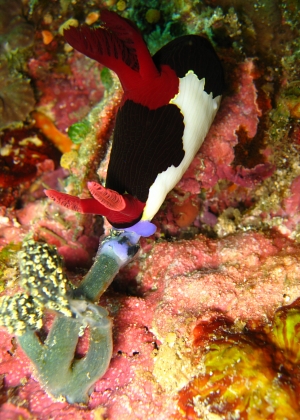
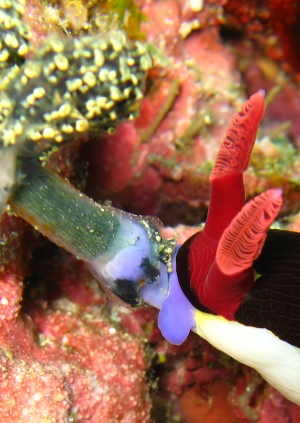
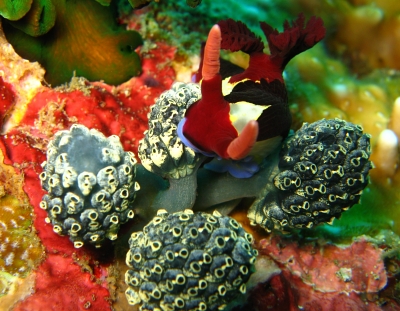
Dear Marcel,
Thanks Marcel for these valuable photos. I am pretty sure this is a colonial ascidian which Gosliner, Behrens & Williams (1996) identify as Oxycorynia fascicularis. The 'head' is in fact a cluster of zooids. In that book, this species and Nembrotha lineolata are both reported to feed on Oxycorynia fascicularis, so it's nice to get a photographic record of it doing this.
-
Gosliner, T.M., Behrens, D.W. & Williams, G.C. 1996. Coral Reef Animals of the Indo-Pacific. Sea Challengers: Monterey, Calif. 1-314.
Best wishes,
Bill Rudman
Nembrotha chamberlaini feeding, Philippines
July 1, 2008
From: Marcel Tanke
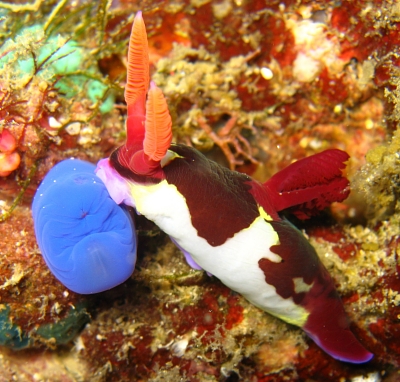
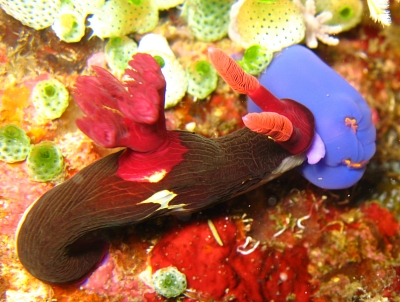
Dear Bill,
During a dive in Puerto Galere we saw a couple of Nembrotha chamberlaini feeding on blue sea squirts. At least it seemed that they were biting in it, I could not see pieces eaten away already. The sea squirts didn't like it, they have their mouths closed.
Locality: Puerto Galere, 15 m, Philippines, 8 February 2008, reef. Length: 10 cm. Photographer: Marcel Tanke.
Best regards,
Marcel
marceltanke@cs.com
Tanke, M.A., 2008 (Jul 1) Nembrotha chamberlaini feeding, Philippines. [Message in] Sea Slug Forum. Australian Museum, Sydney. Available from http://www.seaslugforum.net/find/21651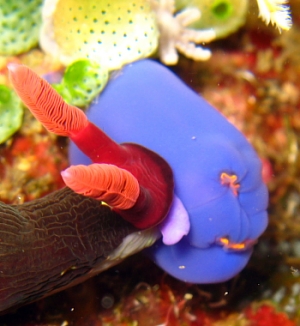
Dear Marcel,
This bright blue ascidian appears to be a species of the genus Rhopalaea. A number of different species of Nembrotha seem to feed on it. Interestingly, most records I have seen of species of Nembrotha feeding on these 'solitary' ascidians suggest that they insert their long tube-like proboscis into what you call the sea squirt's mouths. There is a good photo of N. lineolata doing this in message #16176. As I describe on the ascidian Fact Sheet, the blue object in your photo is a tough leathery sac which protects the soft body parts inside. The 'mouths' you mention are two openings so that a current of fresh sea water is available to the ascidian which feeds by filtering tiny particles from the seawater. The Nembrotha is intersted in the soft fleshy body inside the sac and has found that the easiest way in is through the two openings. I am not sure if it can burrow through the leathery wall of the outer sac. It would be interesting to see if anyone has photos of this happening.
Best wishes,
Bill Rudman
Unicorn Nembrotha chamberlaini
June 30, 2008
From: Marcel Tanke
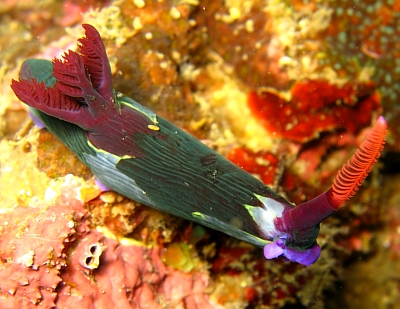
Hi Bill,
In February 2008 in the Philippines, Puerto Galere, we saw this Nembrotha chamberlaini with only one rinophore. I suppose it was a birth defect, as it grew into a very large single rinophore; at least 2 cm.
Something for the Abnormalities page?
Locality: Philippines, 10-15 meter, Puerto Galere, 7 February 2008, reef. Length: 8 cm. Photographer: Marcel Tanke.
Best regards,
Marcel Tanke
marceltanke@cs.com
Tanke, M.A., 2008 (Jun 30) Unicorn Nembrotha chamberlaini. [Message in] Sea Slug Forum. Australian Museum, Sydney. Available from http://www.seaslugforum.net/find/21649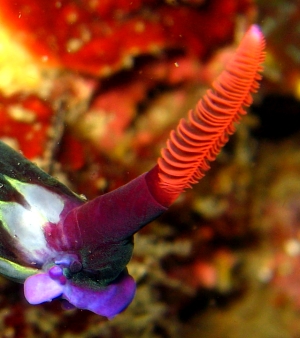
Thanks Marcel,
I assume this green coloured animal is just a colour form of Nembrotha chamberlaini. In a couple of earlier messages you can see animals in which the reddish brown colour of the gills and their base is quite different from the brown saddle of the rest of the dorsum. This would suggest the 'saddle', which is green in your animals, is variable in colour while the gills and their base is not. You are right to compare your animal with unicorn - its single central rhinophore seems twice the size normally found in this species. I've added it to the abnormalities page.
Best wishes,
Bill Rudman
Nembrotha chamberlaini feeding at Komodo
April 21, 2008
From: Natasja Vandeperre
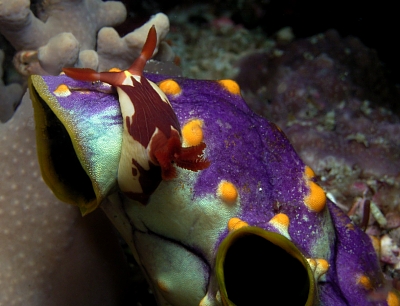
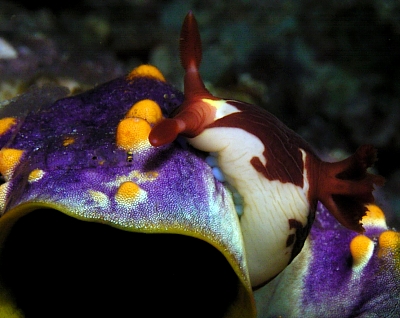
Hello Bill,
Seems like this Nembrotha chamberlaini is feeding.
Locality: Komodo, Indonesia, May 2007. Photographer: Karen Verwulgen.
Greetings,
Natasja
postmaster@naaktslakken.be
Natasja Vandeperre, 2008 (Apr 21) Nembrotha chamberlaini feeding at Komodo. [Message in] Sea Slug Forum. Australian Museum, Sydney. Available from http://www.seaslugforum.net/find/20847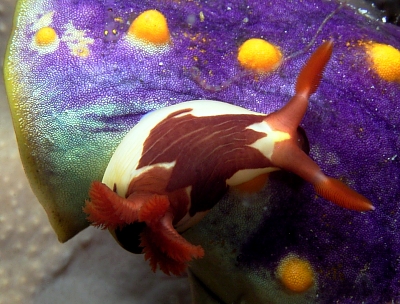
Dear Natasja,
Although it is a Nembrotha on an ascidian, I can't see any sign that it actually feeding. They tend to eat the internal organs rather than the test, and from earlier reports N. chamberlaini seems to prefer other species of ascidian. On the other hand anything is possible, so we can't disregard the possibility that this ascidian is also eaten by this Nembrotha.
Best wishes,
Bill Rudman
Nembrotha chamberlaini feeding on Ascidians (Phillipines)
February 28, 2008
From: James McMahon
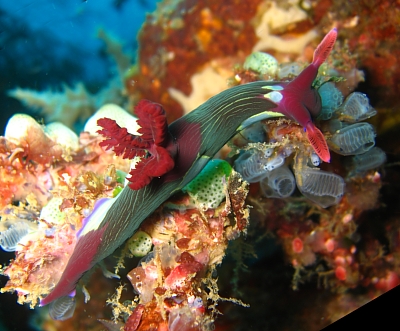
Hi,
I thought you might like this photo of Nembrotha chamberlaini feeding on Ascidians. The photo was taken at the Verde Island wall, near Puerto Gallera, Philippines in July 2007.
Locality: Verde Island, Puerto Gallera, 15 m, Philippines, Pacific Ocean, 17 July 2007, Coral Wall. Photographer: James McMahon.
Regards,
James
james.mcmahon@verizonbusiness.com
McMahon, J.A., 2008 (Feb 28) Nembrotha chamberlaini feeding on Ascidians (Phillipines). [Message in] Sea Slug Forum. Australian Museum, Sydney. Available from http://www.seaslugforum.net/find/21210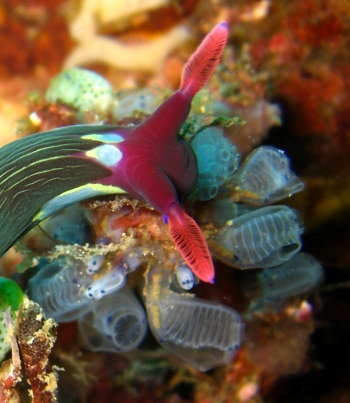
Dear James,
Thanks for this. It seems to be the same ascidian as in Paul Osmond's lower photo [message #19221]. We dont know enough about these ascidian feeders to know just how specific they are, but from records on the Forum this species seems to eat this species and the opaque blue species of Rhopalaea.
Best wishes,
Bill Rudman
Nembrotha chamberlaini feeding
April 18, 2007
From: Mike Krampf
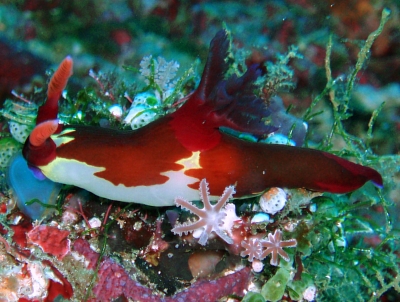
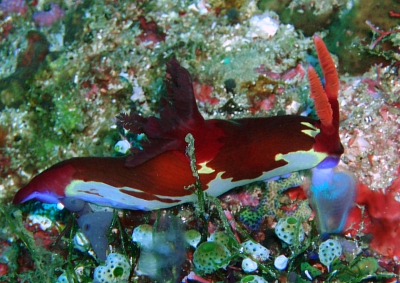
Here is another picture of a Nembrotha chamberlaini feeding on an ascidian.
Locality: Dive Site - Monkey Beach, 50 ft, Puerto Galera, Philippines, South China Sea, 21 Feb 2007, Reef. Length: 4 cm. Photographer: Mike Krampf.
Cheers,
Mike
mtkrampf@yahoo.com
Krampf, M., 2007 (Apr 18) Nembrotha chamberlaini feeding. [Message in] Sea Slug Forum. Australian Museum, Sydney. Available from http://www.seaslugforum.net/find/19563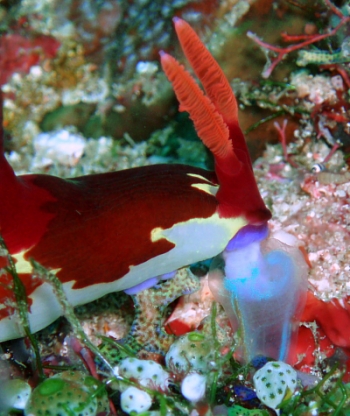
Dear Mike,
This reminds me of Paul Osmond's photos [#19221]. It's good to get multiple records of such observations because it helps us to work out just how specific these animals are to a particular species or genus of ascidian.
Best wishes,
Bill Rudman
Nembrotha chamberlaini feeding on an ascidian
January 19, 2007
From: Paul Osmond
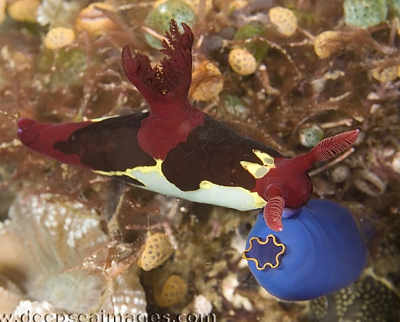
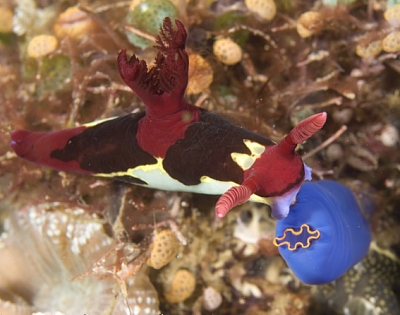
Hi Bill,
Thought you might enjoy this set of images of Nembrotha chamberlaini feeding on an ascidian Rhopalaea sp. It was taken on a trip to Anilao, The Philippines during August of 2006. I see you have a similar imagealready on the forum of this nudibranch associating with this ascidian.
Locality: Mainit Point, 15 m, Anilao, The Philippines, 13 August 2006, patch coral reef. Length: 2 in. Photographer: Paul T Osmond.
When in Anilao you can find this species on any dive - very common locally. Looking through all my images of the species I have only ever seen this species in this area.
I have also included an older image [bottom photo] where this species is all over a similar species of ascidian as well.
Enjoy,
Paul
Deep Sea Images
marriard@deepseaimages.com
Osmond, P.T., 2007 (Jan 19) Nembrotha chamberlaini feeding on an ascidian. [Message in] Sea Slug Forum. Australian Museum, Sydney. Available from http://www.seaslugforum.net/find/19221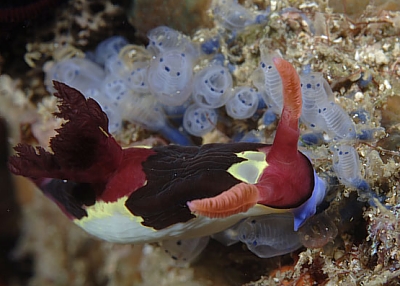
Dear Paul,
Thanks for these nice observations. I am not an expert on ascidians but I understand that this Rhopalaea does range in colour from transparent to opaque so they could be the same species. The lower photos shows the stalk of the ascidian very clearly.
Best wishes,
Bill Rudman
Nembrotha chamberlaini from Bali
October 7, 2003
From: Erwin Kodiat
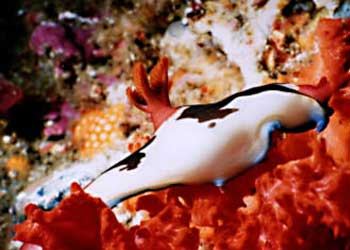
A member of our club [Rochmad Setyadi] took this picture when diving at Gili Biaha, Bali, Indonesia.
Date: 16 Feb 2003
[See www.kapalselam.org/trips.php?id=14.] So it looks like Nembrotha chamberlaini is found outside the Phillipines.
Erwin Kodiat
info@kapalselam.org
Kodiat, E., 2003 (Oct 7) Nembrotha chamberlaini from Bali. [Message in] Sea Slug Forum. Australian Museum, Sydney. Available from http://www.seaslugforum.net/find/11035Thanks Erwin,
This is a useful bit of information. In an earlier message, Peter Vogt has recorded this species from Indonesia, so I guess it's time to change the information on the species Fact Sheet.
Best wishes
Bill Rudman
Nembrotha chamberlaini from the Philippines
October 5, 2003
From: Yukari Sato

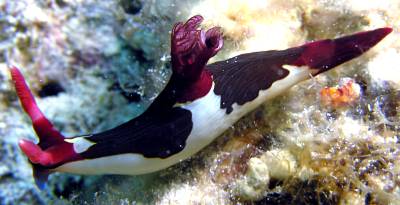
Hello Dr.Rudman,
I am not sure whether this is Nembrotha rutilans or Nembrotha chamberlaini. I would be grateful for your views.
Date: 20 sep 2003
Depth: 10m
Size:approx. 35mm
Location: Lilo-an, Santander, Cebu Is, Philippines
Best wishes,
Yukari Sato
yuks@cg7.so-net.ne.jp
Sato, Y., 2003 (Oct 5) Nembrotha chamberlaini from the Philippines. [Message in] Sea Slug Forum. Australian Museum, Sydney. Available from http://www.seaslugforum.net/find/11084Dear Yukari,
This is Nembrotha chamberlaini.
Best wishes
Bill Rudman
Nembrotha chamberlaini mating
March 7, 2002
From: Todd Garthwaite
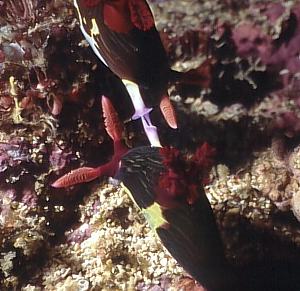
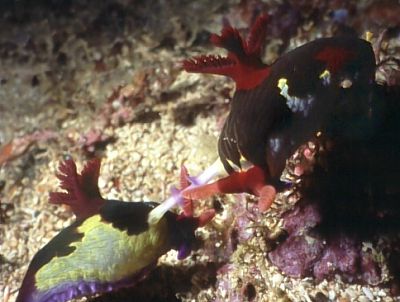
Dear Bill,
Are these two Nembrotha purpureolineata mating? I photographed this pair on December 5, 2001, at 12:39pm at a dive site called 'Kilimar Steps', Puerto Galera, Oriental Mindoro Province, the Philippines. The depth was 18.9 meters, and the water temp. was 26 deg. Celsius. I'm sorry. I don't have any size information.
Stay golden.
Best wishes,
Todd Garthwaite
(Taipei, Taiwan)
typhoontoddy@yahoo.com
Garthwaite, T., 2002 (Mar 7) Nembrotha chamberlaini mating. [Message in] Sea Slug Forum. Australian Museum, Sydney. Available from http://www.seaslugforum.net/find/6323Dear Todd,
Yes these two animals are mating. Nudibranchs are hermaphrodite with fully functioning male and female reproductive organs which open on the right anterior quarter of the body. For some reason, species of Nembrotha when they mate stay quite a distance apart the colourful copulatory organs extending quite some distance. They remind me of the docking devices that are used when planes refuel in the air.
Although it looks very similar to Nembrotha purpureolineata, this species is Nembrotha chamberlaini. There are a number of similarly coloured species. N. chamberlaini seems to differ from the others in having the red colouration of the gill extending down onto the dorsum.
Best wishes,
Bill Rudman
Nembrotha chamberlaini from the Philippines
January 22, 2002
From: Mary Jane Adams

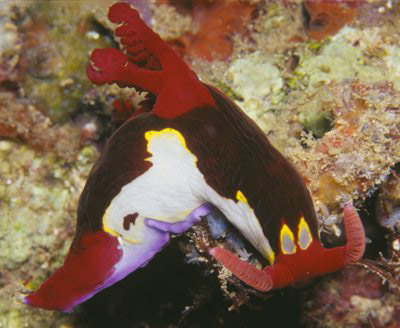
Hi Bill,
Here are a couple of Nembrotha chamberlaini from my May, 2001 trip to Batangas, Philippines. Underwater they looked like they had black backs, however when examined on the surface or photographed with strong strobe light this color was varying shades of red-brown. The pattern of the color splotches varies quite as if each one was individually hand painted.
This species has such large translucent eye spots it makes me wonder if they see better than the average slug.
Best regards,
Mary Jane
divepng@yahoo.com
Adams, MJ. , 2002 (Jan 22) Nembrotha chamberlaini from the Philippines. [Message in] Sea Slug Forum. Australian Museum, Sydney. Available from http://www.seaslugforum.net/find/5977Dear Mary Jane,
The actual eyes are way down on the 'brain' on the inside of the skin, but having a clear pigmentless area above the eyes does ensure that some light gets through. As far as I know 'seeing' in the sense of forming images is beyond all slugs. My understanding is that they can 'see' light and dark, so shadows moving over them can alert them to possible danger, but that's about it.
Best wishes,
Bill Rudman
Nembrotha chamberlaini feeding
September 15, 2000
From: Terry Gosliner
Dear Bill,
The ascidian that Nembrotha chamberlaini is feeding upon is Rhopalaea sp..
Terry
tgosline@calacademy.org
Gosliner, T., 2000 (Sep 15) Nembrotha chamberlaini feeding. [Message in] Sea Slug Forum. Australian Museum, Sydney. Available from http://www.seaslugforum.net/find/3025Thanks Terry,
Bill Rudman.
Nembrotha chamberlaini feeding
September 13, 2000
From: Erwin Koehler
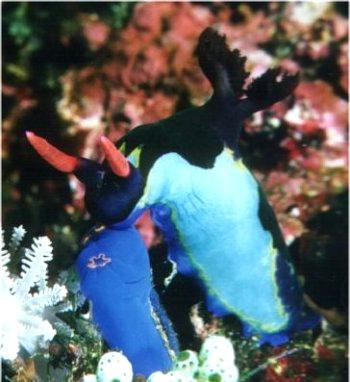
Dear Bill,
Here is a Nembrotha chamberlaini from the Philippines feeding on an ascidian.
Size 3 cm, depth 14 m, Nov. 05, 1998, Panglao Island, divesite "housereef"
Erwin
Medslugs.Koehler@t-online.de
Koehler, E., 2000 (Sep 13) Nembrotha chamberlaini feeding. [Message in] Sea Slug Forum. Australian Museum, Sydney. Available from http://www.seaslugforum.net/find/3017Dear Erwin,
Thanks for another beautiful, and interesting, photo. I wonder if anyone can help with the identity of the ascidian, and for that matter the one you photographed with Nembrotha lineolata.
Best wishes,
Bill Rudman.
Re: Nembrotha chamberlaini from Indonesia
April 19, 1999
From: Pete Vogt
Hi Bill,
Thanks for checking the pics through. I have seen N. chamberlaini before. And although I would agree that the PATTERNING is similar, the actual colouring is strikingly different. Unfortunately the colour-balance of the pics I sent in to you is not spot on. The overall colour of the specimen was a two-tone black anthracite, so much so that we called it Nembrotha stealth. Appendages have similar colouring to N. chamberlaini. What do you think? I have heard a lot recently about the abundant polymorphism in nudis and the consequent difficulties for the taxonomer. What do have here? Intraspecies polymorphism, different colouring through variing diet, or even perhaps a subspeciation of chamb.-like N.? Thanks for your thoughts on this and thanks again for an energetic and vibrant forum!
Cheers Pete
PS: NZ was brilliant - although the water was cold I did some freediving and checked out the local nudis, of which there was a surprising variety.
apnea@rocketmail.com
Vogt, P., 1999 (Apr 19) Re: Nembrotha chamberlaini from Indonesia. [Message in] Sea Slug Forum. Australian Museum, Sydney. Available from http://www.seaslugforum.net/find/791Dear Peter,
My guess is that your animals are a darker colour form of N.chamberlaini. Perhaps Terry Gosliner or Dave Behrens can give us an idea of the variation they have observed. Actually digital imaging is quite good in finding 'invisible' colour patterns. I have found that by deliberately altering colour settings it is possible to find spots and lines on species of gymnodorids which appear uniform orange to the naked eye. A bit like art experts xraying old paintings for clues to their origins.
To return to Nembrotha and colour polymorphism etc. Quite a few species seem to have melanistic (black) colour forms. One example is Tambja morosa which is usually black but often a dull greenish colour in eastern Australia and New Zealand. I still think we have a way to go before we can clarify the color pattern limits of individual species in the genus .. and that is of course linked to finding other worthwhile characters to define species. One thing I am happy to do on the Forum is post colour variations of species so we can build up an awareness of these variations.
Glad you liked New Zealand,
Best wishes,
Bill Rudman.
Nembrotha chamberlaini from Indonesia
February 24, 1999
From: Peter Vogt
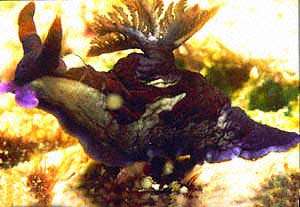
Hi Bill,
Whilst diving around Alor Straights, Nusa Tengara, Indonesia over Xmas I found this Nembrotha. I have not been able to ID it using the books and web sites I have found. Can you help? Thanks very much. The pictures were taken by my buddy Adam Powell, as my system was broken (again) %-(
Thanks for a great forum! It's brill!
Pete Vogt
apnea@ultraviolet.org
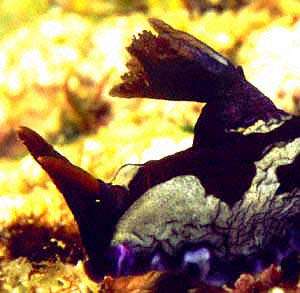
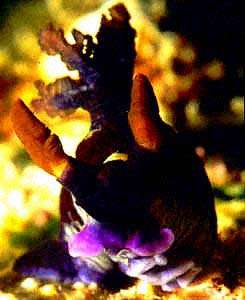
Peter,
Glad you like the Forum. I'm pretty sure your Nembrotha is Nembrotha chamberlaini which you'll see from other messages on this page has only recently been named. If you have any other queries or observations please send them. I've put your details on the Participants Page.
Have fun biking around NZ - the hilly bits will help you discover muscles you didn't know you had!
Bill Rudman.
Observations on Nembrotha chamberlaini
January 8, 1999
From: Erwin Koehler
Dear Bill,
I saw Nembrotha chamberlaini only mating at night (or looking for) never at day. On the other hand, at day they are often found feeding on several tunicate species. Maybe this info is one more piece in the puzzle called science.
Erwin
E.Koehler@deutschepost.de
Koehler, E., 1999 (Jan 8) Observations on Nembrotha chamberlaini. [Message in] Sea Slug Forum. Australian Museum, Sydney. Available from http://www.seaslugforum.net/find/452Thanks Erwin. Any such observations gratefully received.
Bill Rudman.
Re: Philippines Nembrotha
December 16, 1998
From: Terry Gosliner
Dear Bill,
It was great to see Erwin Koehler's photo of our old friend from the Philippines. Dave Behrens and I described this in 1997 (Proceedings of the California Academy of Sciences 49(9):287-308 as Nembrotha chamberlaini. While it is certainly part of a species complex to which Nembrotha lineolata also belongs, animals are very distinctive in their color patterns. There are also some radular differences between members of the complex. The other interesting aspect is that some members of this complex are sympatric, thus reducing the possiblity that they are just geographical variants of a single species.
Terry Gosliner
tgosliner@casnotes1.calacademy.org
Gosliner, T., 1998 (Dec 16) Re: Philippines Nembrotha. [Message in] Sea Slug Forum. Australian Museum, Sydney. Available from http://www.seaslugforum.net/find/389Thanks Terry,
I'm afraid I only got your reprint a few weeks ago and clearly hadn't absorbed all the information it contained. I agree that my suggested "lumping" - although beautiful in its simplicity - probably doesn't reflect the complex relationships between these animals.
I have posted pics of what seem to represent
Nembrotha rutilans and Nembrotha purpureolineata, and put up pics of two other species which appear to be unnamed species 1, species 2.
Bill Rudman.
Re: Philippines Nembrotha
December 16, 1998
From: Dave Behrens
Hi Bill:
Just saw the Nembrotha that Erwin sent you. Sure looks like Nembrotha chamberlaini Gosliner & Behrens 1997. Locality is even the same. Mike Miller posted this species as "Branch of the Week #60" just after the description came out. Terry and I are certainly aware of the problematic variation in the N. lineolata and N. purpureolineolata complexes, but this
species is clearly differentiated by consistent color (see Figures 4 & 5 in our paper) and internal anatomy. Check it out.
Interestingly this is one of the most common nudibranch species in the Batangas region, found on every dive feeding and spawning on the solitary tunicate, Polycarpa aurata.
Thanks
Dave Behrens
dbehrens@schafercorp.com
Behrens, D., 1998 (Dec 16) Re: Philippines Nembrotha. [Message in] Sea Slug Forum. Australian Museum, Sydney. Available from http://www.seaslugforum.net/find/397Thanks for the wakeup call from both Terry and you. I only got your reprint in the last six weeks and I'm afraid after a quick thumb through I had put it on a pile of things to read more deeply over Christmas.
One comforting thought from your quick responses is that although the Sea Slug Forum is not formally "peer reviewed" clearly there are enough participants out there willing to quickly pick up and correct errors.
Best wishes,
Bill Rudman
Re: Nembrotha chamberlaini
December 16, 1998
From: Terry Gosliner
Dear Bill,
Thanks for the message. I was afraid that we had been remiss in getting you a reprint. I really liked your comment on the slowness of the Sydney trains versus the efficiency of the Forum for quick responses. It is definitely the latter.
All the best,
Terry
Terry Gosliner
tgosliner@casnotes1.calacademy.org
Gosliner, T., 1998 (Dec 16) Re: Nembrotha chamberlaini. [Message in] Sea Slug Forum. Australian Museum, Sydney. Available from http://www.seaslugforum.net/find/399Nembrotha from the Philippines
December 12, 1998
From: Erwin Koehler
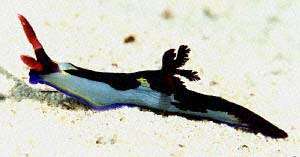
Dear Bill,
attached is a photo of Nembrotha - is this very common Philippine nudi still undescribed as Gosliner, Terrence, David W. Behrens and Gary Williams write in "Coral Reef Animals of the Indo-Pacific"?
Size: 4cm, depth 24m, 29.10.98, housereef, Alona Beach, Panglao (Bohol)
http://www.medslugs.de/E/mssmain.htm
Erwin Koehler
E.Koehler@deutschepost.de
Koehler, E., 1998 (Dec 12) Nembrotha from the Philippines. [Message in] Sea Slug Forum. Australian Museum, Sydney. Available from http://www.seaslugforum.net/find/382Dear Erwin,
I have wondered about this group of species for years. I think they are all part of a variable species. The earliest name appears to be Nembrotha purpureolineata. Any debate welcome!
Bill Rudman.
